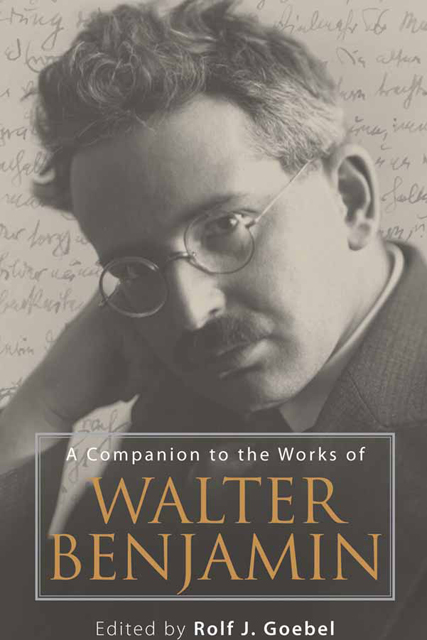Book contents
- Frontmatter
- Contents
- Preface
- Sources of Benjamin’s Works
- Chronology of Benjamin’s Major Works
- Introduction: Benjamin’s Actuality
- 1 Walter Benjamin's Criticism of Language and Literature
- 2 The Presence of the Baroque: Benjamin’s Ursprung des deutschen Trauerspiels in Contemporary Contexts
- 3 Lost Orders of the Day: Benjamin's Einbahnstraße
- 4 Literature as the Medium of Collective Memory: Reading Benjamin’s Einbahnstraße, “Der Erzähler,” and “Das Paris des Second Empire bei Baudelaire”
- 5 Benjamin in the Age of New Media
- 6 One Little Rule: On Benjamin, Autobiography, and Never Using the Word “I”
- 7 The Passagen-Werk Revisited: The Dialectics of Fragmentation and Reconfiguration in Urban Modernity
- 8 Benjamin’s Politics of Remembrance: A Reading of “Über den Begriff der Geschichte”
- 9 The Legacy of Benjamin’s Messianism: Giorgio Agamben and Other Contenders
- 10 Paris on the Amazon? Postcolonial Interrogations of Benjamin’s European Modernism
- 11 Benjamin’s Gender, Sex, and Eros
- 12 Sonic Dreamworlds: Benjamin, Adorno, and the Phantasmagoria of the Opera House
- Select Bibliography and List of Further Reading
- Notes on the Contributors
- Index
4 - Literature as the Medium of Collective Memory: Reading Benjamin’s Einbahnstraße, “Der Erzähler,” and “Das Paris des Second Empire bei Baudelaire”
Published online by Cambridge University Press: 28 February 2023
- Frontmatter
- Contents
- Preface
- Sources of Benjamin’s Works
- Chronology of Benjamin’s Major Works
- Introduction: Benjamin’s Actuality
- 1 Walter Benjamin's Criticism of Language and Literature
- 2 The Presence of the Baroque: Benjamin’s Ursprung des deutschen Trauerspiels in Contemporary Contexts
- 3 Lost Orders of the Day: Benjamin's Einbahnstraße
- 4 Literature as the Medium of Collective Memory: Reading Benjamin’s Einbahnstraße, “Der Erzähler,” and “Das Paris des Second Empire bei Baudelaire”
- 5 Benjamin in the Age of New Media
- 6 One Little Rule: On Benjamin, Autobiography, and Never Using the Word “I”
- 7 The Passagen-Werk Revisited: The Dialectics of Fragmentation and Reconfiguration in Urban Modernity
- 8 Benjamin’s Politics of Remembrance: A Reading of “Über den Begriff der Geschichte”
- 9 The Legacy of Benjamin’s Messianism: Giorgio Agamben and Other Contenders
- 10 Paris on the Amazon? Postcolonial Interrogations of Benjamin’s European Modernism
- 11 Benjamin’s Gender, Sex, and Eros
- 12 Sonic Dreamworlds: Benjamin, Adorno, and the Phantasmagoria of the Opera House
- Select Bibliography and List of Further Reading
- Notes on the Contributors
- Index
Summary
WALTER BENJAMIN WAS FIRST INTRODUCED to postwar Germany by Theodor W. Adorno as one of the initiators of the Frankfurt School of Social Philosophy. As an unorthodox Marxist he was later chosen by the generation of the 1968 revolts to be one of their predecessors. Alternatively, Gershom Scholem emphasized the Jewish and metaphysical roots in Benjamin's intellectual legacy. Ultimately, though, he was discovered by a large readership as the theoretical force behind a non-auratic concept of art, and this has been the basis for his international reputation. Today his fame rests on his having shaped the theoretical basis for and the historical trajectory of twentieth-century media. He is the first to have related the transformation of cultural memory to a historical revolution in communication technology. In his essay “Eduard Fuchs, der Sammler und der Historiker” he defines culture as the “Inbegriff von Gebilden” (“embodiment of creations”) that are independent neither “von dem Produktionsprozeß, in dem sie entstanden” (“from the production process in which they originated”) nor “von dem, in welchem sie überdauern” (GS II.2:477; “a production process in which they continue to survive,” SW 3:267).
Written in 1937 during Benjamin's exile in Paris, this text expresses in theoretical terms what the author had originally sketched out in the short prose pieces in Einbahnstraße (One-Way Street, 1928) and in the literary essays of the 1920s and 1930s. The basis of his argument is the functional difference between spoken and written language, orality and literacy. Furthermore, the function that the written medium has is differentiated according to the technical and social conditions underlying its production. In Benjamin's estimation, the printed text found in novels plays a completely different role than it does in the printed matter generated by the mass press, although both forms must be considered to be the fundamental media of the nineteenth century. This distinction has engendered a popular echo in twentieth-century media theory. Benjamin's analysis, however, is more than simply a consideration of language as the primordial medium, since he also integrates the influence of the newest media forms of his era — photography, film, and radio — into his theoretical considerations. This broadens the scope of his theory, giving it a prognostic value for our telematic age. In his widely read and much cited essay, “Das Kunstwerk im Zeitalter seiner technischen Reproduzierbarkeit” (“The Work of Art in the Age of Its Technological Reproducibility”), Benjamin was able to use his analysis of the cinema to demonstrate that the contents of cultural memory are dependent upon the technical formation of the media in which memory is processed and stored. This specific method links decisive impacts on the transformation of collective memory to media and, indirectly, to the development of the forms of material production. This can also serve as a point of departure for our inquiry into the transformation to which our experience, our knowledge, and our collective memory are subject in the age of electronic reproducibility. From a Benjaminian perspective, tracing the history of media helps to shed light on a highly differentiated corpus of medial forms — oral narration, written text, printed matter, mass press, photography, film, television, personal computer, text messaging — all of which complement one another and yet still maintain their individual function in today's media ensemble.
- Type
- Chapter
- Information
- A Companion to the Works of Walter Benjamin , pp. 91 - 111Publisher: Boydell & BrewerPrint publication year: 2009



